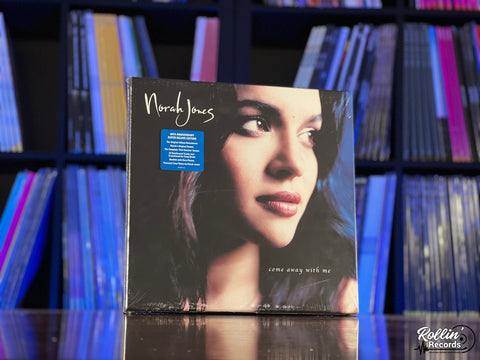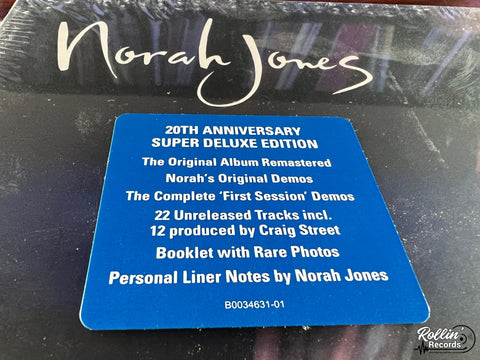Norah Jones


Norah Jones - Come Away With Me (20th Anniversary)(Super Deluxe Boxset)
Super Deluxe 4 LP Packaging: Hardcover book with 12-page booklet inside.
Super Deluxe Edition contains the remastered album, plus 22 previously unreleased tracks including early demos and the never-before-heard first version of the album.
In February 2002, America was still emerging from the dark shadows of the September 11, 2001 terrorist attacks, and Norah’s voice and music—pure, warm, and reassuring—struck a deep emotional chord with listeners the world over. Norah had moved from Texas to New York City in 1999 after spending two years as a jazz piano major at the University of North Texas. While playing jazz gigs at restaurants around town, Norah also fell in with a circle of singer-songwriters including Jesse Harris and Richard Julian who played often at the Living Room on the Lower East Side and inspired her to broaden the creative pathways she might one day take.
On Norah’s 21st birthday, EMI Publishing employee Shell White heard her performing at a jazz brunch and arranged a meeting with Blue Note President Bruce Lundvall. A month later Norah was in Lundvall’s office playing him her 3-song demo CD, which included two jazz songs: “Walkin’ My Baby Back Home” and a remarkably self-assured version of the standard “Spring Can Really Hang You Up The Most” that Norah had recorded in her high school band room accompanying herself on piano. The last song on the CD was one of Harris’ that leaned more in a singer-songwriter direction with Harris on acoustic guitar and Lee Alexander on bass.
Soon after, Lundvall signed Norah to a demo deal, and by the time she went into the recording studio she had decided to focus primarily on new originals written by Harris, Alexander, and herself. “The very first song we did in those sessions was one of Jesse’s, called ‘Don’t Know Why’ that we hadn’t yet played live,” Norah recalls in the new collection’s liner notes. “We got it on the first try and it just felt great, one of those magical, easy takes. When we walked back into the control room to listen, [engineer] Jay [Newland] was over the moon. It really built my confidence for the rest of the session and set the tone for what we were going for. After all was said and done, it was this version that ended up on the final record, with only some harmonies and a doubled guitar added to it.”
Lundvall loved what he heard and signed Norah as a Blue Note artist, and she began to prepare to record her debut album. “Cassandra Wilson’s New Moon Daughter had been a favorite album of mine and was a big inspiration for the kind of record I wanted to make,” Norah writes. “Since I loved the instrument choices (beautiful slide and acoustic guitars) and the production, I asked Bruce if I could meet with Craig Street, who produced it. Craig and I met a few times and got along really well. He liked the demos and said we should put those out as the record or use most of them, but I was really excited to explore a slightly different vibe, one I knew he could help me find.”
Norah and Street went into Allaire Studios near Woodstock in upstate New York with some of her favorite musicians including Bill Frisell and Kevin Breit on guitars, Brian Blade and Kenny Wollesen on drums, Rob Burger on accordion and organ, and Alexander on bass. “Nearly everything we recorded felt special. We re-recorded most of the songs from the demos to see where else we could take them,” Norah recalls. But during the mixing session Norah began to question whether they had gone too far with some of the songs and wondered if Street had been right about the strength of the demos.
After delivering the Allaire mixes to Blue Note, Lundvall came to the same conclusion that the new recordings had strayed too far from what was so special about the demos. It was decided that Norah should go back into the studio to start again with Arif Mardin producing. They ended up keeping three songs from the Allaire sessions (“Seven Years,” “Feelin’ The Same Way,” and “The Long Day Is Over”), two from the demo sessions (“Don’t Know Why” and “Turn Me On”), and recorded nine additional songs that hewed more closely to the spirit of the demos. The resulting album became Come Away With Me.
Now, 20 years later, Norah decided to release the Allaire version of the album. “It’s been a bit like time traveling to some alternate universe of the album that nobody ever heard,” she says. “When I approached Craig to tell him about it, he suggested we ask Tony Maserati to ‘balance’ the recordings. This brought my vocal to the front more and I can finally hear my little 22-year-old self trying new things and fitting into the music around me just fine. Re-visiting these sessions after listening to them only once in the last 20 years has been a lovely surprise. I’m so glad to finally re-unite with Craig and get a chance to finish what we started together. I learned a lot from him, and I always think of that time upstate as a sort of dreamy fantasy, and I still get that feeling when I listen to these recordings.”
As Norah reflects back upon Come Away With Me, she says “I was incredibly proud of this album and so thankful to everyone who made it with me…I figured it was a good first try and felt that it truly captured who I was – musically – at that time, which made me the proudest and is all you can really hope for when making a record. In the end I was so thankful that I got to explore a few different paths before putting them all together. No one, including the label, had any idea it would reach the success that it did. I’m forever grateful to Bruce and the very special team at Blue Note for giving me the chance to find my sound through all of it and for never telling me who I had to be.”
